Nursing Interventions: Comprehensive Report on Patient Care Strategies
VerifiedAdded on 2023/02/01
|6
|1546
|35
Report
AI Summary
This report details nursing interventions for a 23-year-old patient, Mr. Yellow, who underwent surgery following a motor vehicle accident resulting in a right foot amputation and burns. The report outlines the initial nursing assessment, including vital signs and pain levels, followed by the diagnostic process and care planning. It emphasizes the importance of addressing the patient's physiological needs, safety, and security. The report provides a five-day care plan addressing pain management, wound care, and infection prevention, along with interventions for low self-esteem and impaired mobility. Furthermore, it discusses the nurse's actions in response to hypovolemic shock and fever, including contacting the doctor and administering medications. The report also addresses the patient's disorientation and delirium, providing insights into potential causes and appropriate nursing interventions. References from various medical journals support the strategies and interventions discussed in the report.
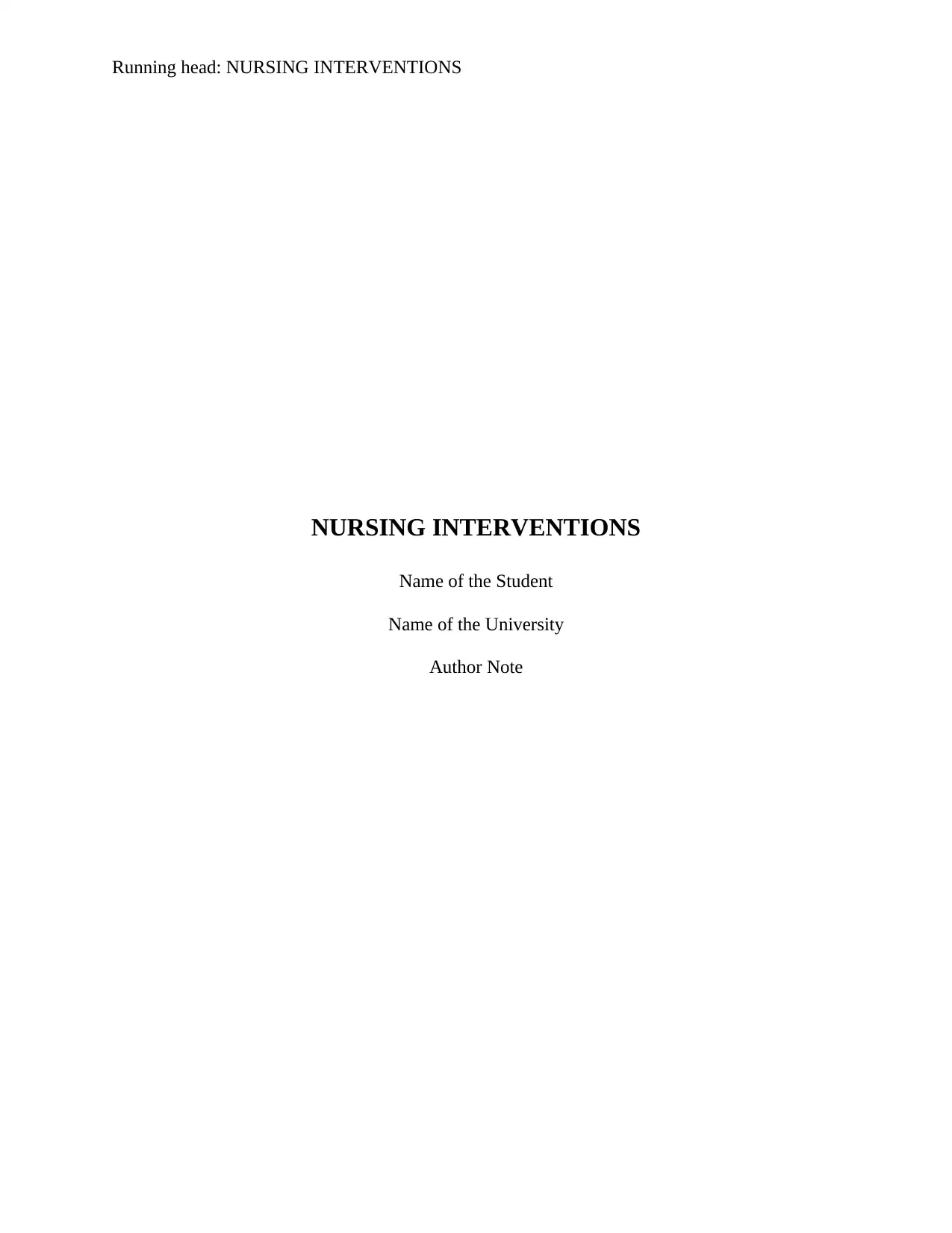
Running head: NURSING INTERVENTIONS
NURSING INTERVENTIONS
Name of the Student
Name of the University
Author Note
NURSING INTERVENTIONS
Name of the Student
Name of the University
Author Note
Paraphrase This Document
Need a fresh take? Get an instant paraphrase of this document with our AI Paraphraser
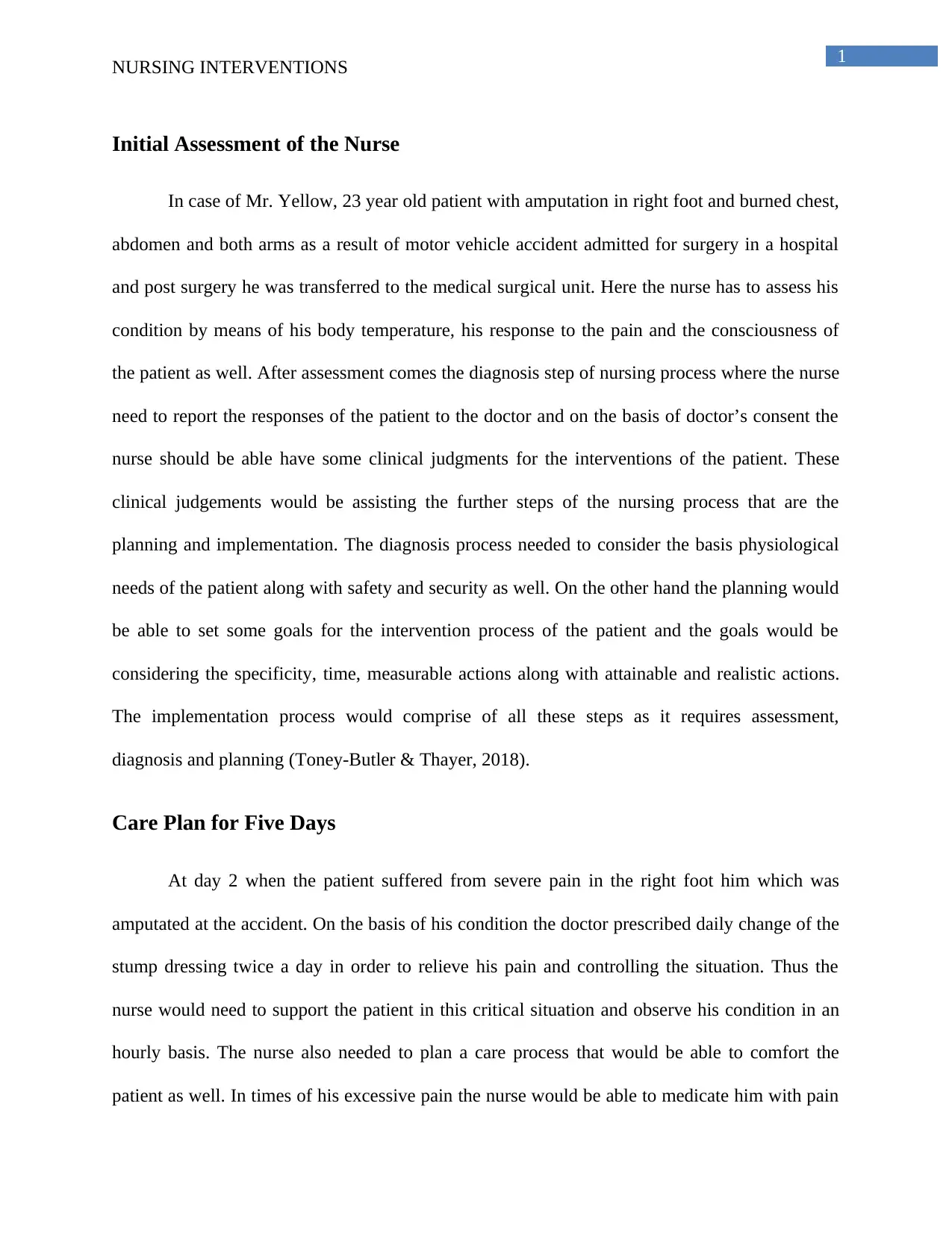
1
NURSING INTERVENTIONS
Initial Assessment of the Nurse
In case of Mr. Yellow, 23 year old patient with amputation in right foot and burned chest,
abdomen and both arms as a result of motor vehicle accident admitted for surgery in a hospital
and post surgery he was transferred to the medical surgical unit. Here the nurse has to assess his
condition by means of his body temperature, his response to the pain and the consciousness of
the patient as well. After assessment comes the diagnosis step of nursing process where the nurse
need to report the responses of the patient to the doctor and on the basis of doctor’s consent the
nurse should be able have some clinical judgments for the interventions of the patient. These
clinical judgements would be assisting the further steps of the nursing process that are the
planning and implementation. The diagnosis process needed to consider the basis physiological
needs of the patient along with safety and security as well. On the other hand the planning would
be able to set some goals for the intervention process of the patient and the goals would be
considering the specificity, time, measurable actions along with attainable and realistic actions.
The implementation process would comprise of all these steps as it requires assessment,
diagnosis and planning (Toney-Butler & Thayer, 2018).
Care Plan for Five Days
At day 2 when the patient suffered from severe pain in the right foot him which was
amputated at the accident. On the basis of his condition the doctor prescribed daily change of the
stump dressing twice a day in order to relieve his pain and controlling the situation. Thus the
nurse would need to support the patient in this critical situation and observe his condition in an
hourly basis. The nurse also needed to plan a care process that would be able to comfort the
patient as well. In times of his excessive pain the nurse would be able to medicate him with pain
NURSING INTERVENTIONS
Initial Assessment of the Nurse
In case of Mr. Yellow, 23 year old patient with amputation in right foot and burned chest,
abdomen and both arms as a result of motor vehicle accident admitted for surgery in a hospital
and post surgery he was transferred to the medical surgical unit. Here the nurse has to assess his
condition by means of his body temperature, his response to the pain and the consciousness of
the patient as well. After assessment comes the diagnosis step of nursing process where the nurse
need to report the responses of the patient to the doctor and on the basis of doctor’s consent the
nurse should be able have some clinical judgments for the interventions of the patient. These
clinical judgements would be assisting the further steps of the nursing process that are the
planning and implementation. The diagnosis process needed to consider the basis physiological
needs of the patient along with safety and security as well. On the other hand the planning would
be able to set some goals for the intervention process of the patient and the goals would be
considering the specificity, time, measurable actions along with attainable and realistic actions.
The implementation process would comprise of all these steps as it requires assessment,
diagnosis and planning (Toney-Butler & Thayer, 2018).
Care Plan for Five Days
At day 2 when the patient suffered from severe pain in the right foot him which was
amputated at the accident. On the basis of his condition the doctor prescribed daily change of the
stump dressing twice a day in order to relieve his pain and controlling the situation. Thus the
nurse would need to support the patient in this critical situation and observe his condition in an
hourly basis. The nurse also needed to plan a care process that would be able to comfort the
patient as well. In times of his excessive pain the nurse would be able to medicate him with pain
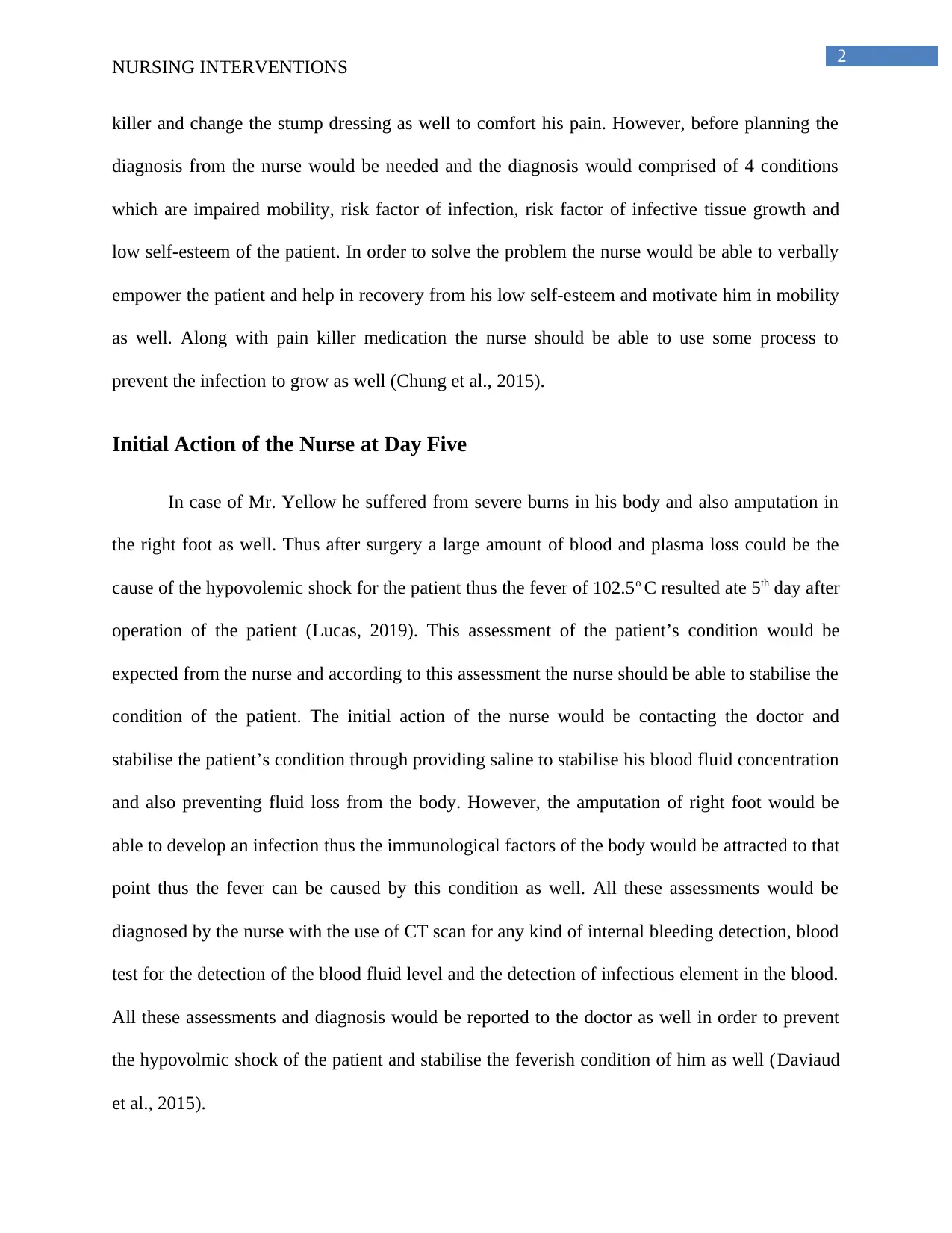
2
NURSING INTERVENTIONS
killer and change the stump dressing as well to comfort his pain. However, before planning the
diagnosis from the nurse would be needed and the diagnosis would comprised of 4 conditions
which are impaired mobility, risk factor of infection, risk factor of infective tissue growth and
low self-esteem of the patient. In order to solve the problem the nurse would be able to verbally
empower the patient and help in recovery from his low self-esteem and motivate him in mobility
as well. Along with pain killer medication the nurse should be able to use some process to
prevent the infection to grow as well (Chung et al., 2015).
Initial Action of the Nurse at Day Five
In case of Mr. Yellow he suffered from severe burns in his body and also amputation in
the right foot as well. Thus after surgery a large amount of blood and plasma loss could be the
cause of the hypovolemic shock for the patient thus the fever of 102.5o C resulted ate 5th day after
operation of the patient (Lucas, 2019). This assessment of the patient’s condition would be
expected from the nurse and according to this assessment the nurse should be able to stabilise the
condition of the patient. The initial action of the nurse would be contacting the doctor and
stabilise the patient’s condition through providing saline to stabilise his blood fluid concentration
and also preventing fluid loss from the body. However, the amputation of right foot would be
able to develop an infection thus the immunological factors of the body would be attracted to that
point thus the fever can be caused by this condition as well. All these assessments would be
diagnosed by the nurse with the use of CT scan for any kind of internal bleeding detection, blood
test for the detection of the blood fluid level and the detection of infectious element in the blood.
All these assessments and diagnosis would be reported to the doctor as well in order to prevent
the hypovolmic shock of the patient and stabilise the feverish condition of him as well (Daviaud
et al., 2015).
NURSING INTERVENTIONS
killer and change the stump dressing as well to comfort his pain. However, before planning the
diagnosis from the nurse would be needed and the diagnosis would comprised of 4 conditions
which are impaired mobility, risk factor of infection, risk factor of infective tissue growth and
low self-esteem of the patient. In order to solve the problem the nurse would be able to verbally
empower the patient and help in recovery from his low self-esteem and motivate him in mobility
as well. Along with pain killer medication the nurse should be able to use some process to
prevent the infection to grow as well (Chung et al., 2015).
Initial Action of the Nurse at Day Five
In case of Mr. Yellow he suffered from severe burns in his body and also amputation in
the right foot as well. Thus after surgery a large amount of blood and plasma loss could be the
cause of the hypovolemic shock for the patient thus the fever of 102.5o C resulted ate 5th day after
operation of the patient (Lucas, 2019). This assessment of the patient’s condition would be
expected from the nurse and according to this assessment the nurse should be able to stabilise the
condition of the patient. The initial action of the nurse would be contacting the doctor and
stabilise the patient’s condition through providing saline to stabilise his blood fluid concentration
and also preventing fluid loss from the body. However, the amputation of right foot would be
able to develop an infection thus the immunological factors of the body would be attracted to that
point thus the fever can be caused by this condition as well. All these assessments would be
diagnosed by the nurse with the use of CT scan for any kind of internal bleeding detection, blood
test for the detection of the blood fluid level and the detection of infectious element in the blood.
All these assessments and diagnosis would be reported to the doctor as well in order to prevent
the hypovolmic shock of the patient and stabilise the feverish condition of him as well (Daviaud
et al., 2015).
⊘ This is a preview!⊘
Do you want full access?
Subscribe today to unlock all pages.

Trusted by 1+ million students worldwide
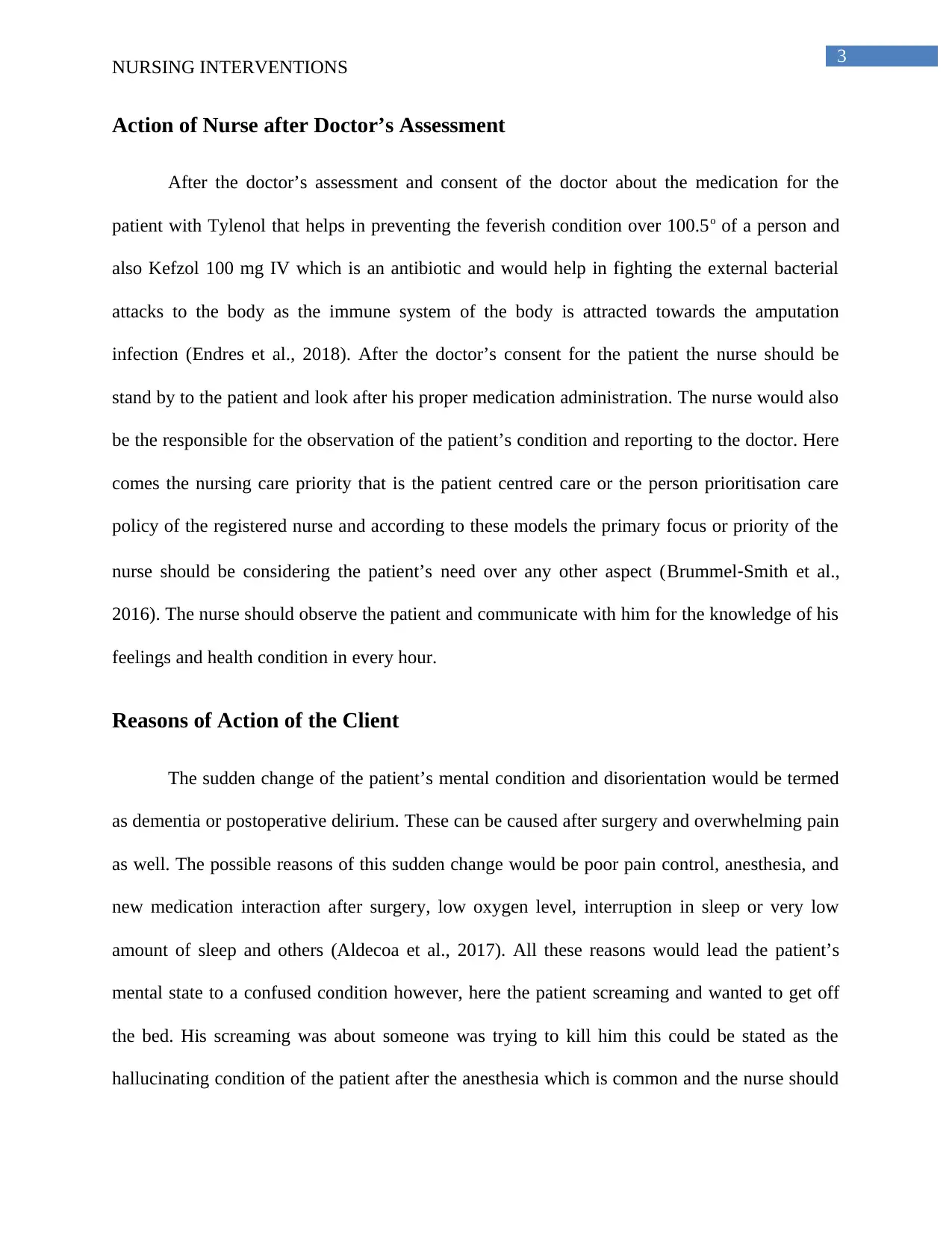
3
NURSING INTERVENTIONS
Action of Nurse after Doctor’s Assessment
After the doctor’s assessment and consent of the doctor about the medication for the
patient with Tylenol that helps in preventing the feverish condition over 100.5o of a person and
also Kefzol 100 mg IV which is an antibiotic and would help in fighting the external bacterial
attacks to the body as the immune system of the body is attracted towards the amputation
infection (Endres et al., 2018). After the doctor’s consent for the patient the nurse should be
stand by to the patient and look after his proper medication administration. The nurse would also
be the responsible for the observation of the patient’s condition and reporting to the doctor. Here
comes the nursing care priority that is the patient centred care or the person prioritisation care
policy of the registered nurse and according to these models the primary focus or priority of the
nurse should be considering the patient’s need over any other aspect (Brummel‐Smith et al.,
2016). The nurse should observe the patient and communicate with him for the knowledge of his
feelings and health condition in every hour.
Reasons of Action of the Client
The sudden change of the patient’s mental condition and disorientation would be termed
as dementia or postoperative delirium. These can be caused after surgery and overwhelming pain
as well. The possible reasons of this sudden change would be poor pain control, anesthesia, and
new medication interaction after surgery, low oxygen level, interruption in sleep or very low
amount of sleep and others (Aldecoa et al., 2017). All these reasons would lead the patient’s
mental state to a confused condition however, here the patient screaming and wanted to get off
the bed. His screaming was about someone was trying to kill him this could be stated as the
hallucinating condition of the patient after the anesthesia which is common and the nurse should
NURSING INTERVENTIONS
Action of Nurse after Doctor’s Assessment
After the doctor’s assessment and consent of the doctor about the medication for the
patient with Tylenol that helps in preventing the feverish condition over 100.5o of a person and
also Kefzol 100 mg IV which is an antibiotic and would help in fighting the external bacterial
attacks to the body as the immune system of the body is attracted towards the amputation
infection (Endres et al., 2018). After the doctor’s consent for the patient the nurse should be
stand by to the patient and look after his proper medication administration. The nurse would also
be the responsible for the observation of the patient’s condition and reporting to the doctor. Here
comes the nursing care priority that is the patient centred care or the person prioritisation care
policy of the registered nurse and according to these models the primary focus or priority of the
nurse should be considering the patient’s need over any other aspect (Brummel‐Smith et al.,
2016). The nurse should observe the patient and communicate with him for the knowledge of his
feelings and health condition in every hour.
Reasons of Action of the Client
The sudden change of the patient’s mental condition and disorientation would be termed
as dementia or postoperative delirium. These can be caused after surgery and overwhelming pain
as well. The possible reasons of this sudden change would be poor pain control, anesthesia, and
new medication interaction after surgery, low oxygen level, interruption in sleep or very low
amount of sleep and others (Aldecoa et al., 2017). All these reasons would lead the patient’s
mental state to a confused condition however, here the patient screaming and wanted to get off
the bed. His screaming was about someone was trying to kill him this could be stated as the
hallucinating condition of the patient after the anesthesia which is common and the nurse should
Paraphrase This Document
Need a fresh take? Get an instant paraphrase of this document with our AI Paraphraser
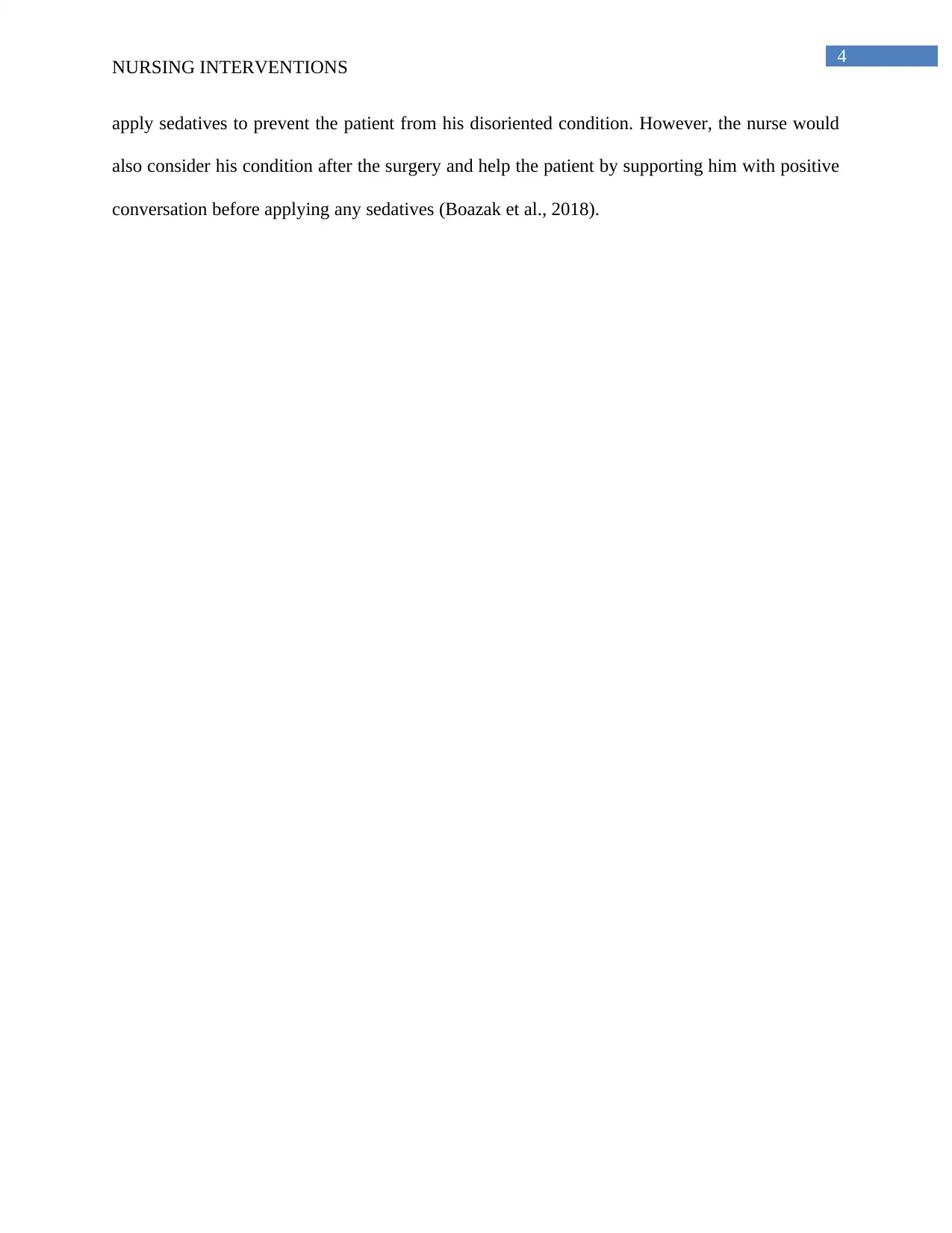
4
NURSING INTERVENTIONS
apply sedatives to prevent the patient from his disoriented condition. However, the nurse would
also consider his condition after the surgery and help the patient by supporting him with positive
conversation before applying any sedatives (Boazak et al., 2018).
NURSING INTERVENTIONS
apply sedatives to prevent the patient from his disoriented condition. However, the nurse would
also consider his condition after the surgery and help the patient by supporting him with positive
conversation before applying any sedatives (Boazak et al., 2018).
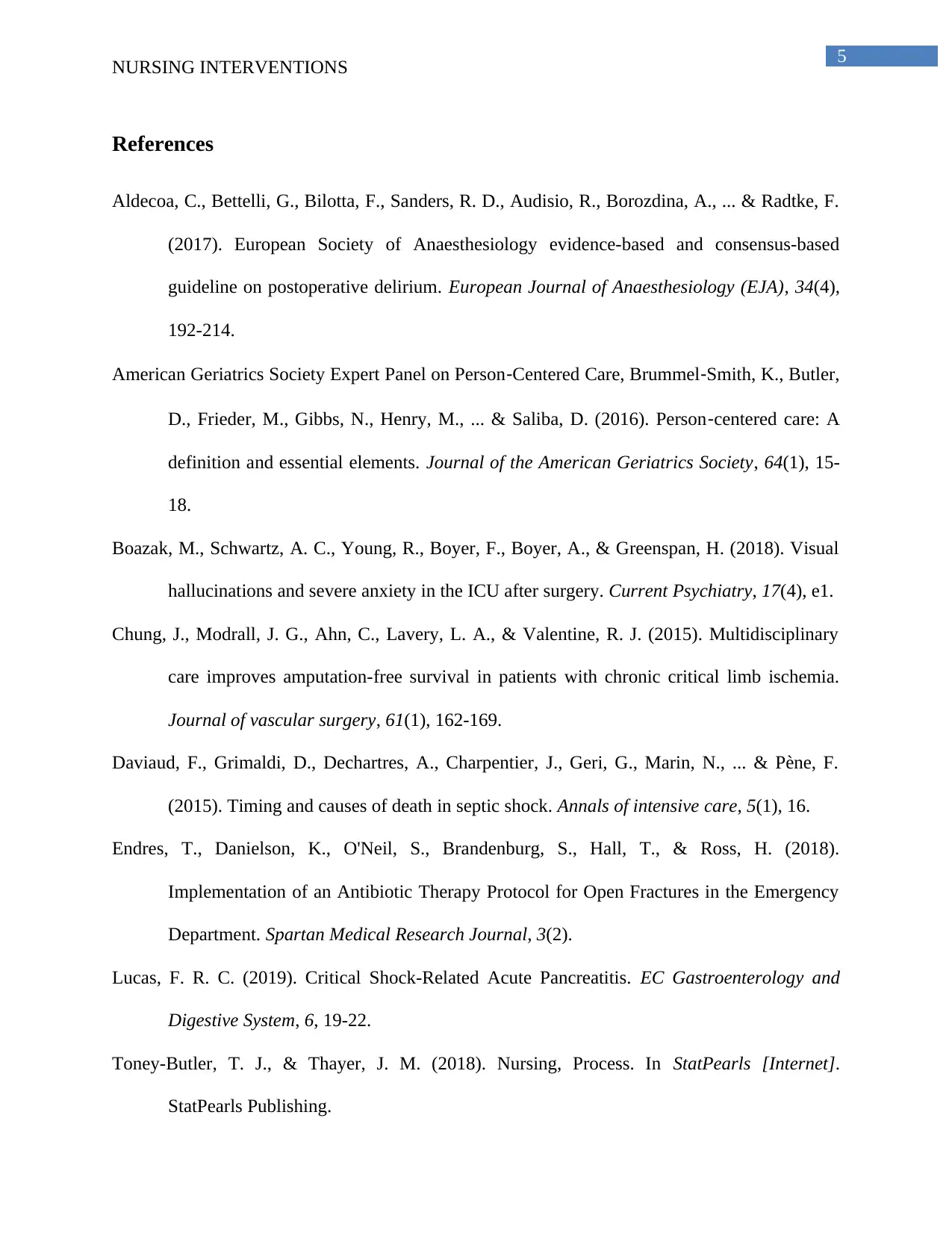
5
NURSING INTERVENTIONS
References
Aldecoa, C., Bettelli, G., Bilotta, F., Sanders, R. D., Audisio, R., Borozdina, A., ... & Radtke, F.
(2017). European Society of Anaesthesiology evidence-based and consensus-based
guideline on postoperative delirium. European Journal of Anaesthesiology (EJA), 34(4),
192-214.
American Geriatrics Society Expert Panel on Person‐Centered Care, Brummel‐Smith, K., Butler,
D., Frieder, M., Gibbs, N., Henry, M., ... & Saliba, D. (2016). Person‐centered care: A
definition and essential elements. Journal of the American Geriatrics Society, 64(1), 15-
18.
Boazak, M., Schwartz, A. C., Young, R., Boyer, F., Boyer, A., & Greenspan, H. (2018). Visual
hallucinations and severe anxiety in the ICU after surgery. Current Psychiatry, 17(4), e1.
Chung, J., Modrall, J. G., Ahn, C., Lavery, L. A., & Valentine, R. J. (2015). Multidisciplinary
care improves amputation-free survival in patients with chronic critical limb ischemia.
Journal of vascular surgery, 61(1), 162-169.
Daviaud, F., Grimaldi, D., Dechartres, A., Charpentier, J., Geri, G., Marin, N., ... & Pène, F.
(2015). Timing and causes of death in septic shock. Annals of intensive care, 5(1), 16.
Endres, T., Danielson, K., O'Neil, S., Brandenburg, S., Hall, T., & Ross, H. (2018).
Implementation of an Antibiotic Therapy Protocol for Open Fractures in the Emergency
Department. Spartan Medical Research Journal, 3(2).
Lucas, F. R. C. (2019). Critical Shock-Related Acute Pancreatitis. EC Gastroenterology and
Digestive System, 6, 19-22.
Toney-Butler, T. J., & Thayer, J. M. (2018). Nursing, Process. In StatPearls [Internet].
StatPearls Publishing.
NURSING INTERVENTIONS
References
Aldecoa, C., Bettelli, G., Bilotta, F., Sanders, R. D., Audisio, R., Borozdina, A., ... & Radtke, F.
(2017). European Society of Anaesthesiology evidence-based and consensus-based
guideline on postoperative delirium. European Journal of Anaesthesiology (EJA), 34(4),
192-214.
American Geriatrics Society Expert Panel on Person‐Centered Care, Brummel‐Smith, K., Butler,
D., Frieder, M., Gibbs, N., Henry, M., ... & Saliba, D. (2016). Person‐centered care: A
definition and essential elements. Journal of the American Geriatrics Society, 64(1), 15-
18.
Boazak, M., Schwartz, A. C., Young, R., Boyer, F., Boyer, A., & Greenspan, H. (2018). Visual
hallucinations and severe anxiety in the ICU after surgery. Current Psychiatry, 17(4), e1.
Chung, J., Modrall, J. G., Ahn, C., Lavery, L. A., & Valentine, R. J. (2015). Multidisciplinary
care improves amputation-free survival in patients with chronic critical limb ischemia.
Journal of vascular surgery, 61(1), 162-169.
Daviaud, F., Grimaldi, D., Dechartres, A., Charpentier, J., Geri, G., Marin, N., ... & Pène, F.
(2015). Timing and causes of death in septic shock. Annals of intensive care, 5(1), 16.
Endres, T., Danielson, K., O'Neil, S., Brandenburg, S., Hall, T., & Ross, H. (2018).
Implementation of an Antibiotic Therapy Protocol for Open Fractures in the Emergency
Department. Spartan Medical Research Journal, 3(2).
Lucas, F. R. C. (2019). Critical Shock-Related Acute Pancreatitis. EC Gastroenterology and
Digestive System, 6, 19-22.
Toney-Butler, T. J., & Thayer, J. M. (2018). Nursing, Process. In StatPearls [Internet].
StatPearls Publishing.
⊘ This is a preview!⊘
Do you want full access?
Subscribe today to unlock all pages.

Trusted by 1+ million students worldwide
1 out of 6
Related Documents
Your All-in-One AI-Powered Toolkit for Academic Success.
+13062052269
info@desklib.com
Available 24*7 on WhatsApp / Email
![[object Object]](/_next/static/media/star-bottom.7253800d.svg)
Unlock your academic potential
Copyright © 2020–2025 A2Z Services. All Rights Reserved. Developed and managed by ZUCOL.




